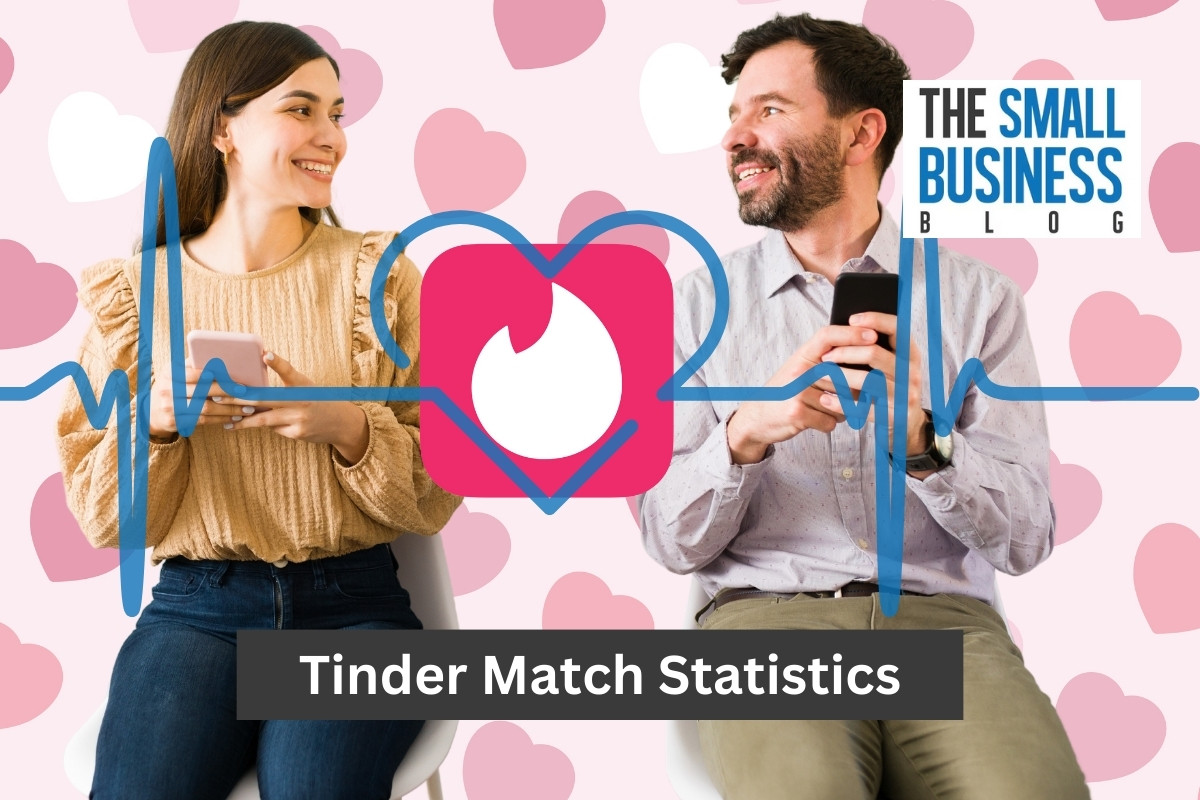If you were to take a deep dive into Tinder match statistics, you’d find there’s a lot more data than just the number of left or right swipes.
Essentially, every demographic you can think of uses the platform, but there are many factors that influence how people interact with each other.
It’s no secret that women tend to have more options than men, as they receive roughly seven matches every day on average.
People are spending a lot of time on Tinder, as there are roughly 1.6 billion swipes taking place on a daily basis.
There are quite a few pros and cons related to online dating, and Tinder is seen as a pioneer in this space with the rise of mobile applications.
In this article, you’ll get a look at the most relevant Tinder match statistics, and you might be surprised at what you find.
Post Contents
Key Statistics
- Users are generally the most active on Tinder between Thursday and Sunday
- By the end of 2023, it’s estimated that there will be 25.7 million Tinder users in the U.S.
- 40% of men and 50% of women prefer to know if their match has any kids upfront
- There have been over 60 billion matches made on Tinder in total
- Around 10% of Tinder users in the U.S. pay for premium features on the app
- Tinder boasts 75 million users worldwide, 78.1% of which are men
- 30% of Tinder’s user base is married
- Surprisingly, most matches tend to be made on Mondays between the hours of 6pm and 9pm
Tinder Match Statistics

As the online dating industry extends its reach, more and more people are bound to lean on it for a number of reasons.
From 2023 to 2030, this market is expected to grow by 7.4%.
You can guess that Covid caused many more people to flood the dating apps, and their popularity continues to rise.
There are several popular dating apps, but Tinder is seen as a leader in the market, with many competitors following in their footsteps.
People realize that these applications make it much easier to connect with others.
Of course, this comes with a blend of success and horror stories.
Nevertheless, the following statistics will delve into a few key focus areas in Tinder statistics.
1. The Weekend is Your Best Bet
If you’re looking to spend a little time swiping, your time is best spent doing it during the weekends.
This makes sense as people have more free time, allowing them to swipe or potentially meet up with a new date.
Statistics show us that Thursday to Sunday is the perfect window if you’re looking for the most engagement on the platform.
This doesn’t always guarantee success, but you’re more likely to land a match if you’re active when others are as well.
It also helps that your profile can show a green online button.
Some might find this conflicting with the data that highlights Mondays as another beneficial day for swiping, but the weekend is a go-to for most people.
When people don’t have work in the way, they’ll spend more time than usual swiping away on Tinder.
Getting the match is the first step, and swiping during peak hours is a great way to increase those chances.
(EnterpriseAppsToday)
2. Tinder Has a Large Market in the U.S.
It isn’t hard to see why, but the numbers are impressive nonetheless.
Tinder is undoubtedly successful in the United States, as the app is on track to have 25.7 million users in the U.S. alone.
When you consider the roughly 75 million global users, the U.S. takes up a third of that figure by itself.
Tinder is popular in many different countries throughout the world and has actually been the cause of many new long-distance relationships.
There are many aspects of Tinder that continue to bring in new, interested users.
Being able to connect with others of the same or opposite sex anywhere in the world is truly a modern-age blessing.
People are taking advantage, and users in the United States see the convenience of it, especially considering the busy culture of the modern lifestyle.
(EnterpriseAppsToday)
3. Some Preferences are More Common Than Others
When it comes to relationships, especially online dating, users are going to have their own list of unique preferences.
You might feel like some are flat-out ridiculous, but others are entirely understandable.
Looking at the data, it seems 40% of men and 50% of women want to know if their Tinder match has any kids as soon as possible.
No one is going to argue you with that, as it’s a significant responsibility to take on.
However, in the same vein, this has led to some problems or discouragement on the platform.
Two people may hit it off in many ways, but having a kid could be a dealbreaker.
What’s more interesting is the percentage of users who don’t care to know if a kid is involved or not.
Once again, everyone’s agenda is different when it comes to online dating, which is partly why people seem to be so strict with their preferences.
Most people go through a lot of swiping before they find a match that’s actually compatible.
(EnterpriseAppsToday)
4. Total Number of Matches on Tinder
Tinder has been around since 2012, so it has a little skin in the online dating game.
With it’s substantial user base, you can assume the platform has raked in a lot of swipes over the years.
The total number of matches recorded on Tinder has exceeded 20 billion, and this number continues to climb as we speak.
A figure that seems untouchable for competitors who came years later, Tinder boasts next-level engagement when it comes to the online dating market.
Another angle that’s fun to think about is the number of relationships that were formed from these matches.
Moreover, how many of these matches brought different cultures together throughout the world?
Tinder offers a travel feature, allowing you to swipe in various countries and make new connections with people you would have otherwise never met.
It can be a blessing and a curse, depending on how you look at it.
(Gitnux)
5. Premium Features in the U.S.
A majority of Tinder’s user base is fine with the free version of the app.
For those looking for some additional features, they can sign up for a subscription, and Tinder has a few options to choose from.
Each of these brings something unique to the table.
Take a look at the table below to compare the different types of premium features available on Tinder.
| Features | Free Plan | Tinder Plus | Tinder Gold | Tinder Platinum |
| Swipe, match, and chat | ✅ | ✅ | ✅ | ✅ |
| Passport To Any Location | ✅ | ✅ | ✅ | |
| Unlimited Likes | ✅ | ✅ | ✅ | |
| Unlimited Rewinds | ✅ | ✅ | ✅ | |
| Hide Ads | ✅ | ✅ | ✅ | |
| 5 Super Likes Every Week | ✅ | ✅ | ||
| See Who Swipes On You | ✅ | ✅ | ||
| 1 Free Boost Each Month | ✅ | ✅ | ||
| New Top Picks Daily | ✅ | ✅ | ||
| Prioritized Likes | ✅ | |||
| Message Before Matching | ✅ | |||
| See Your Sent Likes From the Past 7 Days | ✅ |
As you can see, there’s a little bit of something for everyone, depending on what you’re trying to accomplish.
Around 10% of Tinder users in the United States pay for some kind of premium feature.
If anything, Tinder Plus tends to be the most popular upgrade for people looking to give some new features a test run.
Tinder Plus is only $7.99 per month, and many people find the unlimited likes, rewinds, and passport feature to be entirely worth it.
This seems to be a great option for people who want to meet others outside their immediate area but don’t have the luxury to physically do so at the time.
(Gitnux)
Match Rate and Message Frequency Statistics
If you were to ask individual users, you’re guaranteed to hear a bunch of varying sentiments to match rates on Tinder.
While some people have all the luck in the world, others barely see any interaction at all.
This isn’t new, as the dating world has always been ruthless, but the ups and downs of dating come at you fast in regard to online dating.
Match rate statistics will not only vary based on surface level preferences of each user but also due to cultural norms, demographics, conflicting locations, and much more.
Even if you get a match on Tinder, it’s a gamble whether a message is initiated or not.
Online dating takes a lot of perseverance.
This becomes crystal clear after you review various statistics on match rate and message frequency on the platform.
6. What’s Wrong With Glasses?

The title of this section may sound odd, but apparently, it matters when it comes to online dating.
Users who include photos of themselves wearing glasses may encounter a 15% reduction in potential matches.
As unfortunate as this may be, it’s a clear look at the preferences of some users, as wearing glasses must be a deal breaker.
This could potentially hurt the ego of some, but all this means is they weren’t the right person for you.
Nevertheless, this small statistic also highlights how challenging the modern dating world can be.
It seems like people’s list of preferences only gets longer with each passing year.
That 15% isn’t a guarantee, but there’s enough data to support a trend line with people who wear glasses.
Some people find it to be attractive, others not so much, and that’s simply the nature of how preferences work with people.
(EnterpriseAppsToday)
7. Men are Quick to Message First
Although this isn’t true in every circumstance, women are generally sitting on more matches than the average guy on Tinder.
With these options comes a delay in response time for some users.
While 63% of men send the first message within five minutes of matching, only 18% of women do the same.
In some cases, this isn’t because they don’t want to talk; it’s because many men are being drowned out by other matches.
With Tinder and online dating in general, it’s really a numbers game.
Rejection hurts, but you can’t let every interaction on Tinder get you down.
A lot of men are prompt with their messages as they know a new match is a slowly closing window.
On average, women take around 38 minutes to send a message, and this is only if they’re actually active on the platform.
(EnterpriseAppsToday)
8. Match Rates are Higher with Passport
There are many different factors that play into match rates in various parts of the world.
You can expect that more populated areas or “tourist” destinations will lead to a higher number of matches.
People love to use Tinder’s passport feature, and a lot of them tend to choose popular travel destinations to find new matches.
Here are the cities where people use the passport feature the most:
- New York City
- London
- Tokyo
- Paris
- Delhi
- Los Angeles
- Sao Paulo
- Bangkok
- Stockholm
- Mexico City
As you can see, all of these are popular cities, and it has led to many more matches than let’s say, some rural part of the U.S.
This is another testament to how Tinder is a numbers game.
There was also a sizeable uptick in the usage of the passport feature during Covid.
When governments put everyone into lockdown, Tinder made their passport feature free for quite some time.
Users from all over the world made use of the feature during lockdown, and a lot of them stayed in touch or fell into relationships down the road.
(DatingZest)
9. When Tinder Matches Decide to Meet
The struggle that comes with Tinder is that even when a match happens, there’s only a chance that you’ll actually end up meeting the person.
Many times, this is the right choice, but other times, you might feel like you missed out on something.
Nevertheless, you might be surprised to learn that 95% of Tinder matches decide to meet within two to seven days after they matched.
Some people might feel like this is rushed, but others see no need to beat around the bush.
Other notable statistics related to this topic include the following:
- Over one million dates are planned every week because of Tinder
- 30 million matches happen every day on the app
- 60+ billion matches have been registered in total
- 1.63% is the average match rate on Tinder
Regardless of your specific experience on the platform, navigating Tinder can be exhausting for anyone.
Dating online and in the modern world in general is challenging, but millions have eventually found what they’re looking for through perseverance.
(DatingZest)
10. How Many Matches End in Marriage?

This statistic can’t be defined 100% accurately, but there’s enough data available to get pretty close.
Although this figure will definitely fluctuate over time, around 13.6% of Tinder matches could potentially lead to marriage.
This requires the right circumstances, which consider many factors, but people continue to prove that it works.
Tinder and online dating is definitely not for everyone, but it’s a necessary evil in the climate of the dating world.
It isn’t your only option when it comes to dating, but it’s pretty effective for those who don’t want to rely on traditional methods.
While some profiles explicitly state they’re looking for marriage material, others simply end up there by sticking with it.
Online dating comes with a few discomforts at first, but many people would be surprised to hear how many matches end up being success stories.
(TechJury)
Tinder Demographic and Market Statistics
Aside from how people interact with each other on the platform, it’s also interesting to look at the details behind the types of people who use Tinder.
In addition to that, the following sections will highlight different statistics related to the online dating market as a whole.
There’s no argument that Tinder holds a strong position in the market, but they’re definitely not the only player that’s relevant.
Reviewing demographics and market insights will show you just how big Tinder and the online dating industry actually are.
11. Separating Users by Age Group
Tinder isn’t only for the young, as you’re guaranteed to find all age groups actively using the online dating app.
Even though Tinder’s user base is pretty diverse, it’s still primarily dominated by the younger crowd.
Take a look at the chart below to see the various age groups throughout Tinder’s user base.
Another interesting angle you can consider is how many different age groups interact with each other on Tinder.
In everyday life, it isn’t so common for varying generations to end up in the same dating environment.
Tinder helps to break these barriers down, with many people exploring outside their immediate age group.
As mentioned earlier, Tinder isn’t the only player in the online dating space.
There are many other companies involved, so it can also help to review how market share is broken down between them all.
(EnterpriseAppsToday)
12. Market Share of Online Dating Apps
With Tinder leading the way, you have apps like Bumble, Hinge, and Plenty of Fish that are not too far behind.
The most recent statistics show that Tinder currently has a market share of 32.32%, with Bumble behind it at 22.22%.
The chart below provides a full scope of market share stats between all relevant online dating services.
Tinder will likely dominate the online dating market, but that doesn’t mean there isn’t space for other services to succeed.
Considering how Tinder branded itself over a decade ago, it’ll be hard for another online dating service to top what the company has accomplished so far.
You’ll also want to keep in mind that various dating apps are more popular in certain regions throughout the world.
It’s clear that the U.S. primarily leans on Tinder, but this isn’t the case for everyone across the world.
Just as Tinder has a dedicated user base, apps like Bumble boast many of their own as well.
(EnterpriseAppsToday)
13. Where Do Users Live?
We aren’t talking about exact addresses, but more so the types of communities, environments, and neighborhoods they live in.
For example, data shows that roughly 76% of Tinder users live in urban environments.
Of course, this comes with relatively broad imagery and includes urban environments of many different sizes.
You can break down where users live into the following three categories:
- Urban: 76%
- Suburban: 17%
- Rural: 7%
Online dating apps have proven to be effective in urban environments.
Nodding back to the numbers game comment, if you’re in a city with millions of people, it’ll be easier to get matches when compared to rural towns.
(DatingZest)
14. Tinder Has a Large LGBTQ+ Community

An interesting data point taken from 2020 shows that the LGBTQ+ community accounted for 20% of all matches on Tinder during that year.
This likely stems from a few factors, such as the pandemic and the introduction of Tinder’s orientation feature in 2019.
Once people were able to openly identify their orientation, it seemed to bring in more users from many different communities.
It isn’t uncommon for people to use more than one dating app, but Tinder has found a way to cater to most audiences.
Even with us being years past the pandemic and social interaction changing drastically, the LGBTQ+ community is bigger than ever on Tinder.
They’re a driving force for the application now that Tinder has made their features and environment more inclusive over the years.
(WebsiteBuilder)
The Bottom Line
Even if you aren’t a fan of online dating, there’s a good chance you’ve heard about Tinder on and off over the years.
Many people consistently rely on the platform, while there are plenty of others who have never once made an account.
Nevertheless, the relevance of online dating continues to widen as it becomes more of a norm in our modern world.
This article dives into some of the most standout Tinder match statistics that unveil the reality behind the online dating platform.






























